Table of contents
- Technology: motors / drive The load change on a motorcycle
- The performance often only starts jerkily
- Sophisticated mechanics support fine motor skills
- Tips and tricks for a better load change behavior
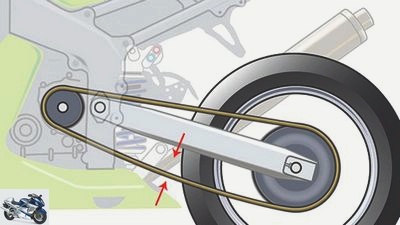
Drawing: archive
counselor
technology & future
Technology: The load change on a motorcycle
Technology: motors / drive
The load change on a motorcycle
Rough load changes can thwart elegant cornering. MOTORRAD explains the causes and gives tips to alleviate the phenomenon.
Werner Koch
02/18/2010
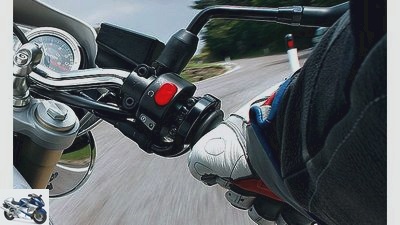
j.kuenstle.de
Even jerky acceleration often leads to uneven driving behavior.
Strictly speaking, the term load change behavior describes two driving states. First the moment when the gas is closed and the motor switches from pull to push mode. Instead of driving the rear wheel, the motor is kept running by the moment of inertia of the vehicle’s masses when coasting. Depending on the design, the motor brakes more or less strongly and abruptly. A thick two-cylinder generates a significantly higher braking torque than a small, low-resistance 125 two-stroke.
Buy complete article
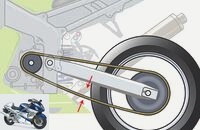
Technology: motors / drive
The load change on a motorcycle
4 pages) as PDF
€ 2.00
Buy now
If the driver then accelerates again, the motor switches from push mode to traction and drives the rear wheel. Unfortunately, on many motorcycles this process does not go smoothly either, but rather generates a more or less strong jolt depending on the speed and gear level. This jolt can cause the speed to change suddenly and make a steering correction necessary when cornering. In addition, the load change jolt affects the suspension on the telescopic fork, which reacts with an abrupt dive or rebound. Which ultimately contributes to the unrest in the chassis and steering.
The performance often only starts jerkily
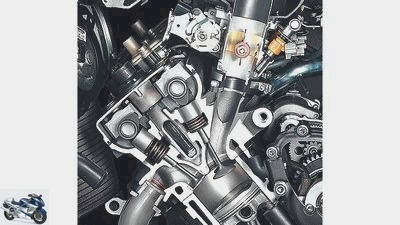
archive
The basic cause of the jerky use of power is the combustion pressure in the engine. Depending on the speed and throttle position, the torque on the crankshaft increases abruptly due to the combustion in the cylinder and accelerates the rear wheel abruptly, benefiting from the play in the drive train.
In the age of extreme emissions regulations, however, engine engineers have tied their hands. Nevertheless, all sorts of tricks are used to make the transition as smooth as possible, even with injection engines, by supplying the engine with an extremely lean, but just ignitable mixture in the transition to overrun mode and thus reducing the braking torque. However, this does not work in all operating states, so that the engine continues to decelerate abruptly there.
The engine can react just as abruptly when accelerating. Because exactly at the moment when a cylinder is supplied with fresh gas again by the injection nozzles and ignites, the speed and torque on the crankshaft suddenly increase. However, this ignition pulse is not sent directly to the rear wheel, where it is slowed down and dampened by a large resistance, but can get real momentum through the play in the drive train and accelerate the motorcycle with a jolt of force. The bigger the game, the harder the load changes go across the stage. And the lighter the crankshaft or its rotating masses are, the rougher the power input. So it’s no wonder that agile, high-revving super sports engines accelerate much harder than sluggish chopper drives with massive and heavy crankshafts.
Small example: the crankshaft of a current 600 series sports machine weighs around 9.9 kilograms, that of a Kawasaki cruiser with a two-liter engine weighs a whopping 24 kilograms. The rotating inertia forces are many times higher than with the sports engine due to the larger diameter of the V2 hub disks.
In order to soften the hard, first ignition beat, it is also very important that the throttle valves open as small an angle as possible when you gently apply the gas.
Sophisticated mechanics support fine motor skills
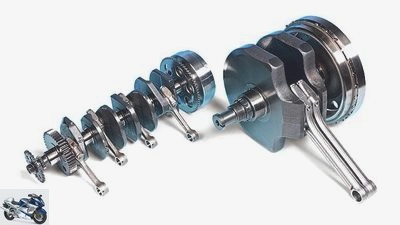
archive
Light crankshafts (left) with a small diameter of the cam disks make the engine agile and lively, but dampen the hard ignition less than a shaft with large, heavy cam disks and corresponding inertia (right).
Another decisive factor is the play in the drive train, i.e. between the crankshaft and the rear wheel. Play can already build up on the clutch due to the integrated shock absorbers. Even more play results from the free angle of rotation of the claws on the gear wheels, which rotate between around ten and thirty degrees depending on the gear. The larger the angle of rotation, the better the shiftability, but the rougher the load changes. In addition, there is play due to the necessary or, in the case of poor maintenance, too large chain slack.
If you add the play of the shock absorbers between the chainring and the rear wheel, the crankshaft has a free angle of rotation of up to 180 degrees, depending on the gear and gearbox design, before the ignition stroke reaches the rear wheel and thus a clearly defined resistance. There the load peaks collide with the second shock absorber. If this is knocked out and can be turned a few degrees without resistance, the rubber dampers must be replaced. Little trick: rubber dampers with too little preload can be preloaded more strongly by sticking correspondingly thick aluminum sheets to the hub. This also reduces the angle of rotation in the drive train and reduces the load change shock. It is precisely this unrestrained force of the internal combustion engine that spoils the fun in tight bends and city traffic for so many motorcyclists.
Tips and tricks for a better load change behavior
Since the electronically controlled injection can only be optimized with a lot of effort (and then usually without a TuV-approved procedure), the only way left is to set certain parameters correctly.
- For example, playing in the throttle cable. If the throttle cable can be operated with too much play at the beginning, the driver can do the “Pressure point” the throttle is difficult to detect. The result: he runs over the “Pressure point” when accelerating too quickly and tearing open the throttle valve accordingly violently. If, on the other hand, the play is just as tight as possible, the driver can open the throttle valve in a finely dosed manner from the first millimeter. When reducing the play in the opener throttle cable, make sure that the cable has a little play even when the handlebars are fully turned. It may be necessary to readjust the closer throttle cable to reduce the play in order to achieve smooth, low-friction operation.
- The next step: the optimal reduction of the chain tension or the chain slack. To see how strong the chain is “tighten” the swing arm is deflected so far that the rear axle, swing arm axis and the center of the gearbox output shaft are on a line. In this state, the chain must be able to be moved up or down about 10 to 15 millimeters with light pressure (halfway between the pinion and the chain wheel). If this value is reached, the rear wheel is completely relieved and the chain slack is measured again at the same measuring point. This value is noted and will serve as a point of reference for an optimal chain tension in the future in order to reduce the load change shock with this method as well.
- When driving at low speeds, for example in tight hairpin bends, annoying load change jolts can be contained with the help of the rear brake. The speed is controlled in slow corners, for example, by keeping the gas slightly open and adjusting the desired speed with gentle pressure on the brake pedal. This saves you having to close and open the throttle and the associated unrest in the chassis. This trick helps to create a round, fluid curve, especially when driving on passes. And don’t worry, the thermal stress on the brake disc and pads is completely harmless at speeds below 50 km / h.
Related articles
-
PS reader question about motorcycle technology – translation for the racetrack
Werner Koch 14th pictures factstudio.de 1/14 How do you find the right translation for the racetrack? factstudio.de 2/14 Quick change transmissions in GP…
-
How to change the clutch on your motorcycle
counselor workshop How to change the clutch on your motorcycle Workshop: clutch change, part 1 How to change the clutch on your motorcycle Engage first…
-
Motorcycle technology – maintaining drum brakes, part 1
Marcel Schoch 50 pictures Marcel Schoch 1/50 After two passes with a total of two tenths of a material removal, the brake drum is ready for use again….
-
PS reader question about motorcycle technology crash pads
Henniges 7th pictures Wiessmann 1/7 Picture gallery, technology: Are crash pads in makes sense in each case? Katrin Sdun 2/7 These crash pads are not…
-
PS reader question about motorcycle technology – cleaning the radiator
www.factstudio.de, Joachim Schahl 7th pictures archive 1/7 Picture gallery, technical question: cleaning coolers. Werner Koch 2/7 When the delicate…
-
PS reader question on motorcycle technology – tire wear on the racetrack
jkuenstle.de 5 pictures markus-jahn.com 1/5 “What is the reason for the flaky, frayed way in which racing tires are destroyed??”, asks us reader Holger…
-
Technology: new motorcycle frame concept
Melly Technologies counselor technology & future Technology: new motorcycle frame concept Technology: new motorcycle frame concept Blockbusters With the…
-
PS reader question about motorcycle technology
jkuenstle.de counselor technology & future PS reader question about motorcycle technology PS reader question about motorcycle technology Beam or banana…
-
White Motorcycle Concepts WMC250EV: electric speed record
White Motorcycle Concepts 15th pictures White Motorcycle Concepts 1/15 White Motorcycle Concepts wants the world speed record for electric motorcycles….
-
Braking properly with the motorcycle
Jahn counselor Driving experience & Driving tips Braking properly with the motorcycle Brake properly Braking with and without ABS Motorcycles ride well…